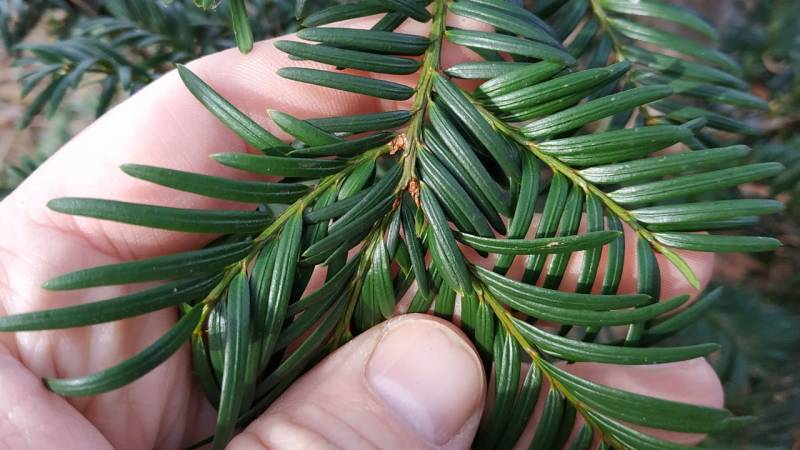
Identify and recognize 5 familiar coniferous trees by their needles
👉 The key facts from this guide
- Learn how to identify spruces, firs, pines, yews, and Douglas firs by their needles.
- Spruces have two white stomatal bands on the underside of the needles and a suction cup on the needles.
- Firs have sharply pointed and hard needles.
- Pines have multiple needles at the base of the leaf (usually two in Germany).
- Yews have a needle tip with a small stem that transitions to the branch and a green scale at the end.
- Douglas firs emit a lemon-like scent when their needles are crushed.
Do you know how to identify our most famous needle trees?
I didn't know — so I went on a journey.
In a forest, I found all five representatives.
Now learn how to identify our native needle trees based on their needles.
The video guide
Watch my video where I introduce all five needle trees and how to recognize and identify them (in German).
The fir
The fir is widespread in Germany and all over the world. It grows 30 to 50 meters tall — sometimes over 65 meters.
It grows narrowly conical, and an identifying feature is the upright cones.
A fir tree can live up to 500 to 600 years under favorable conditions.
Now let's look at the needles:
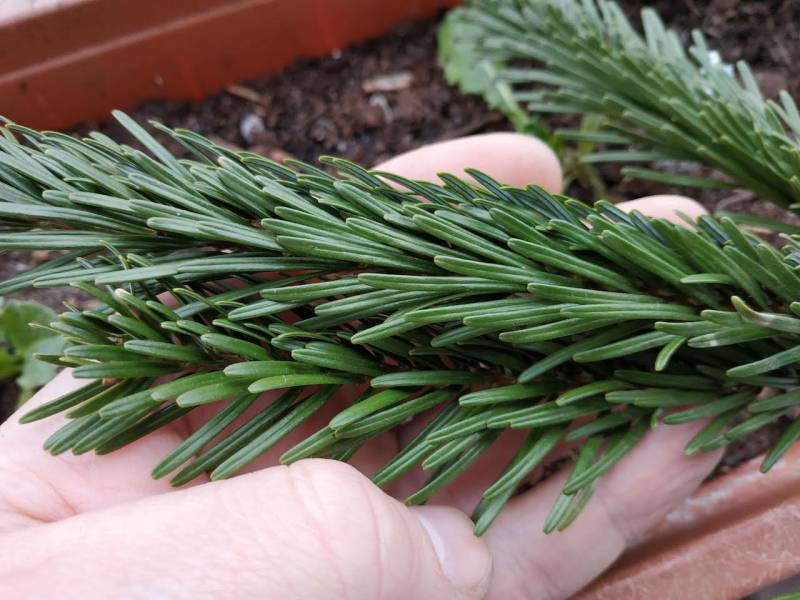
The two distinct white stomata stripes underneath the needles are visible in the lower picture.
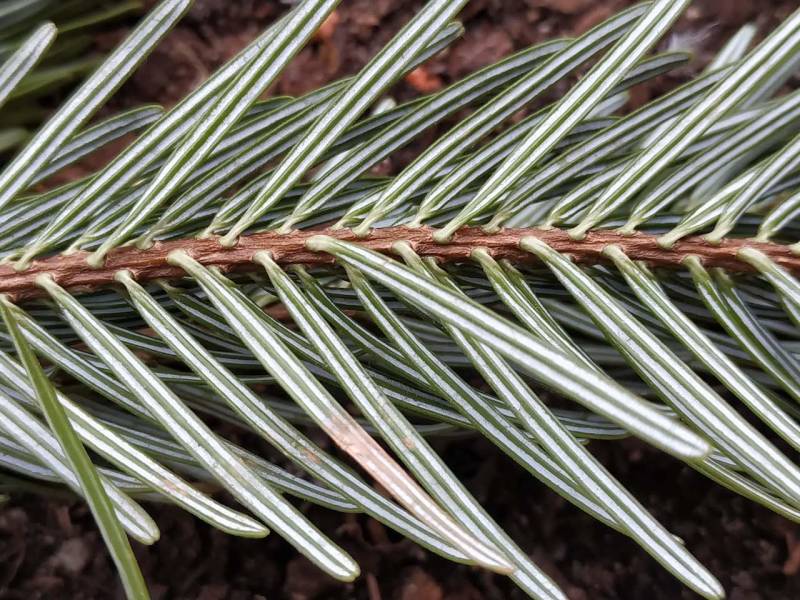
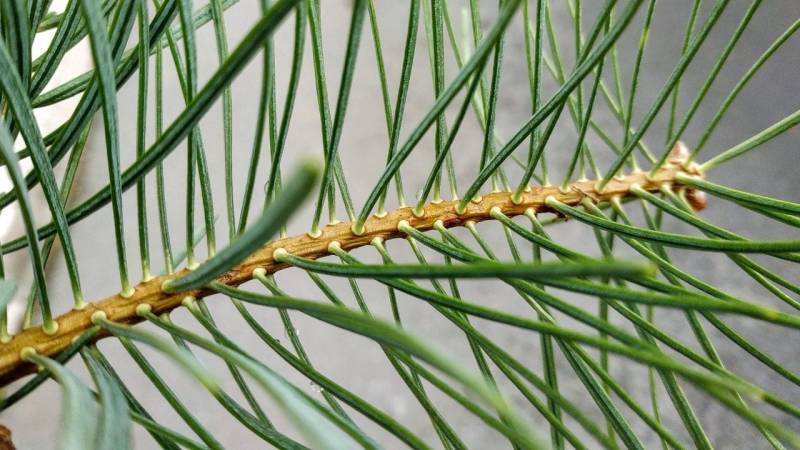
Identifying firs by their needles
Distinct identifying features compared to the other listed needle trees:
- Two distinct white stomata stripes on the underside of the needles
- The needle base sits on the branch with a small suction cup
Other characteristics of the fir
| Color of needles | fresh green, green, bluish-green, grayish-green, glossy dark green, light green depending on species |
| Length of needles | vary in length depending on the species of fir |
| Needle tip | rounded |
| Underneath of needles | two distinct white stomatal lines; needle base with suction cup on branch |
Bushcraft and Survival Facts About Fir
The fir tree has some edible parts, such as:
- the young, soft shoot tips (for example, as tea)
- the cambium (cooked in spring)
- flower buds as a spice
- the seeds (for example, roasted)
The wood of the fir tree is similar to that of the spruce tree. Both woods are almost identical and very similar in their properties.
The Spruce Tree
The common spruce tree grows to about 40 meters high (in exceptions up to 50 meters).
The spruce tree is typical of its sharp needles, hanging cones, and straight, columnar trunk.
The spruce tree lives to be about 200 to 300 years old (exceptions are 500 to 600 years).
Now, about the needles:
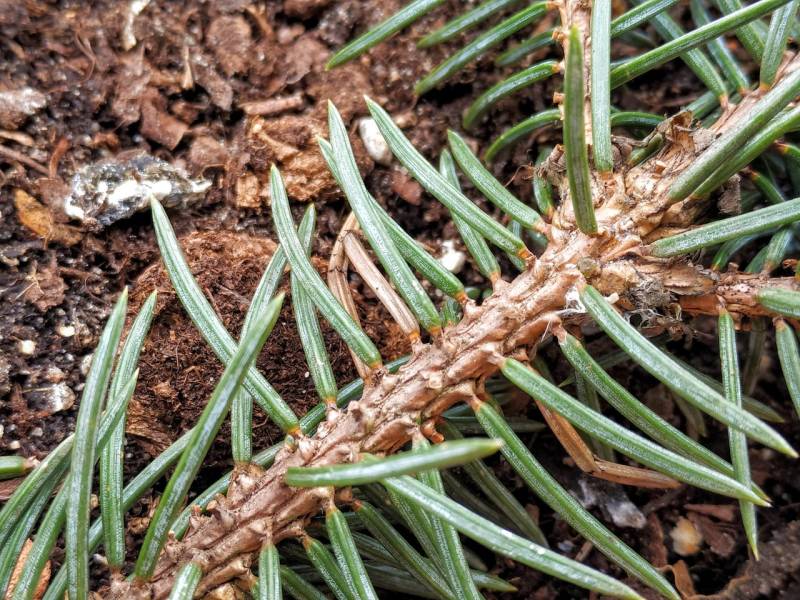
Identifying Spruce Trees by Their Needles
Good distinguishing feature compared to other listed conifers:
- The needles are hard and sharp (it really hurts, other common conifers don't sting as much)
- The base of the needle is woody (not like a suction cup like the fir tree)
Additional characteristics:
| Color of needles | green, dark green, blue-green, gray |
| Length of needles | 0.8 to 3 cm depending on the species |
| Tip of needles | stiff, slightly pointed, pointed to very pointed depending on the species |
| Underside of needles | sometimes two white stomatal bands |
Bushcraft and Survival facts about spruce trees
The spruce tree has some edible parts, such as:
- the cones
- the cambium
- the bud tips
- the flower buds
- the seeds
- the needles
The energy-rich parts are the seeds.
For outdoor craftsmen, spruce wood is a great building and construction wood. It can be easily sawn, planed, drilled, sanded, and split.
The Pine Tree
In our native forests, you mainly find the black pine and the forest pine.
Pine trees can grow up to 30 meters (rarely up to 40 meters) high. Age: 200 to 300 years (individual specimens 500–600 years).
Pine trees usually have two needles at the base of the leaf. Other pine species have up to 5 needles at the base of the leaf.
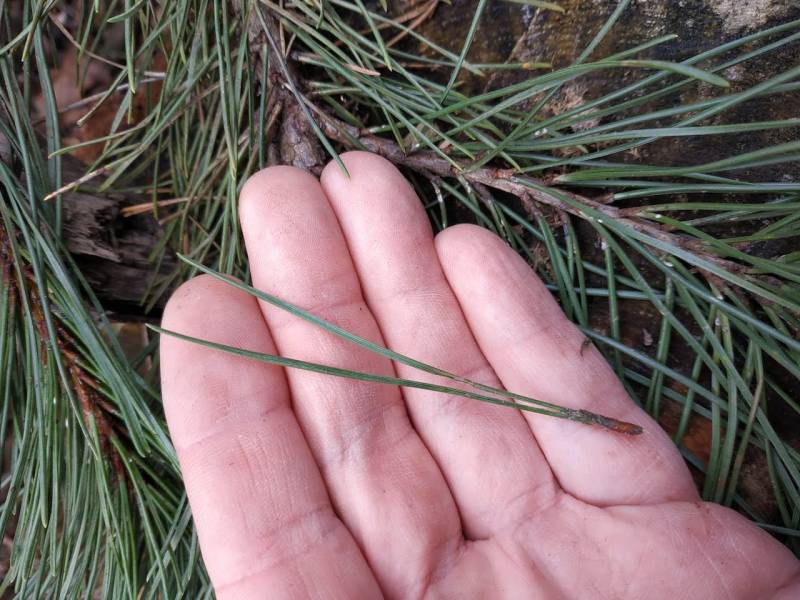
Identification features of the pine tree
Distinguishing feature compared to other listed conifers:
- Multiple needles at the base of the leaf (usually two to five)
Other features:
| Needle color | dark green, bluish-green |
| Needle length | 4 to 7 cm long |
| Needle tip | roundish to slightly pointed |
| Underside of needle | no difference from upper side |
Bushcraft and survival facts about the pine tree
The pine tree has some edible parts, such as:
- the cones
- new growth tips (e.g., for tea)
- the seeds
- the flowers
The energy-rich parts are the seeds.
Like the spruce, the pine tree is also a great building and construction wood for bushcrafters. It can also be easily worked and split with a knife.
The Yew Tree
The yew tree grows 10 to 15 meters tall. Occasionally, up to 20 meters. This makes the conifer one of the smallest conifers in our forests.
Unfortunately, the yew tree only occurs sporadically or when actively planted.
Attention: The yew tree is poisonous due to the poison Taxin. Needles, seeds, wood, even the sawdust when turning – everything is poisonous to us humans.
Did you know that deer and deer can eat yew trees without hesitation, but we humans can die from it? 30 to 50 needles are probably enough. The same goes for cows, goats, and horses: the risk of death is high if they eat yew trees.
The bark of the yew tree consists of a reddish-brown bark that later becomes scaly.
The needles are spirally arranged on the leading shoots. They grow in two rows on the lateral branches.
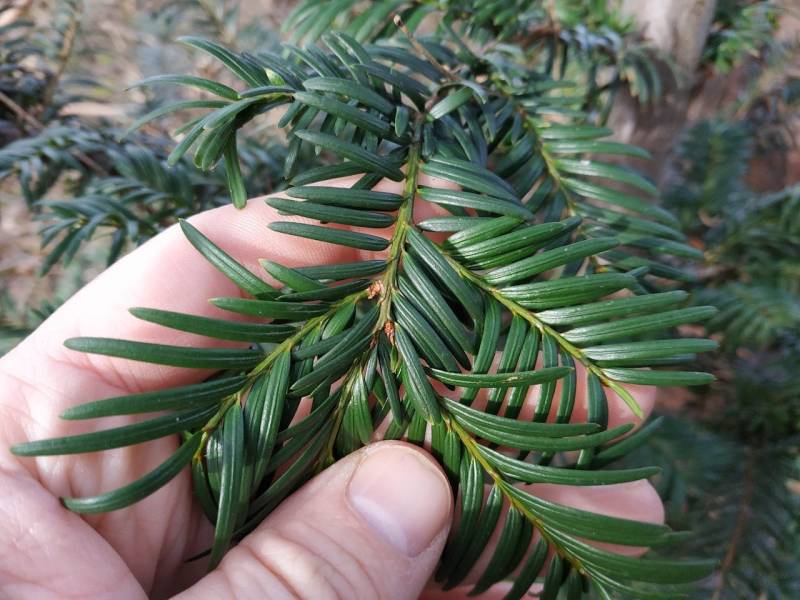
The seeds of the yew tree are surrounded by red flesh. But attention, these are not berries, even if it seems so at first glance.
The flesh wraps around the seed, but does not completely enclose it. The seed protrudes from the top.
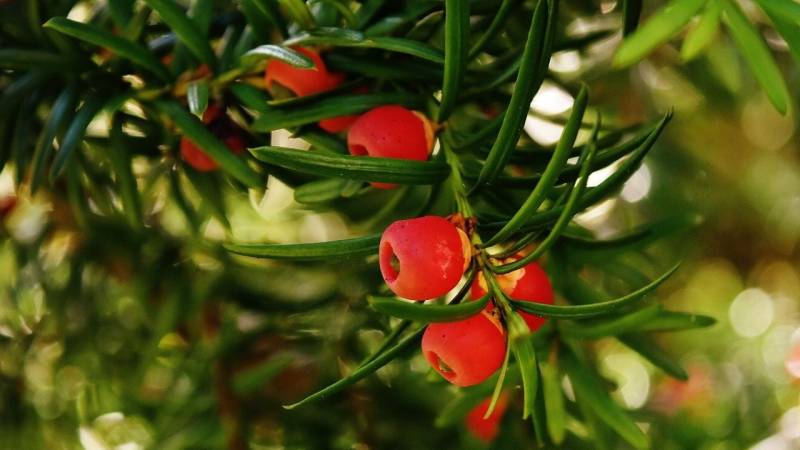
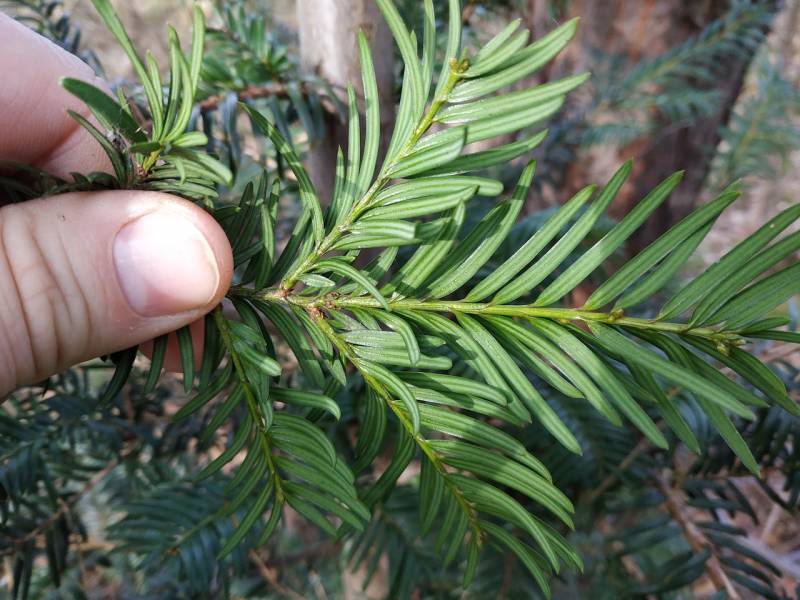
Identification Characteristics of the Yew Tree
A good distinguishing feature compared to the other listed conifers:
- The end of the needle has a small stem that merges into the branch. At the end, a green scale sits on the branch.
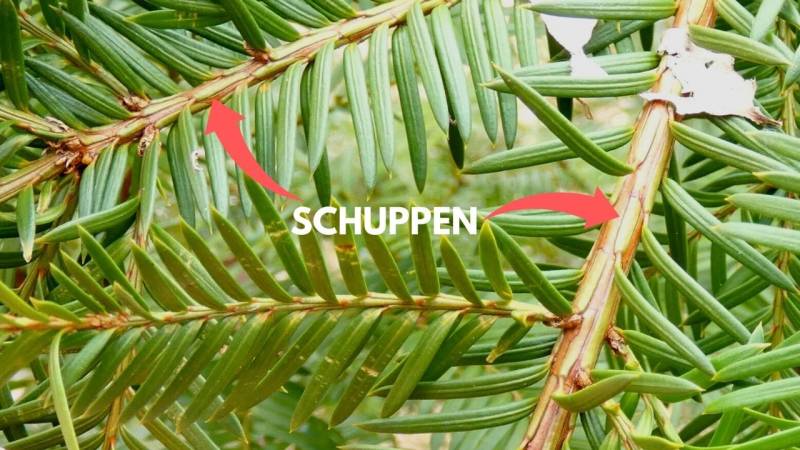
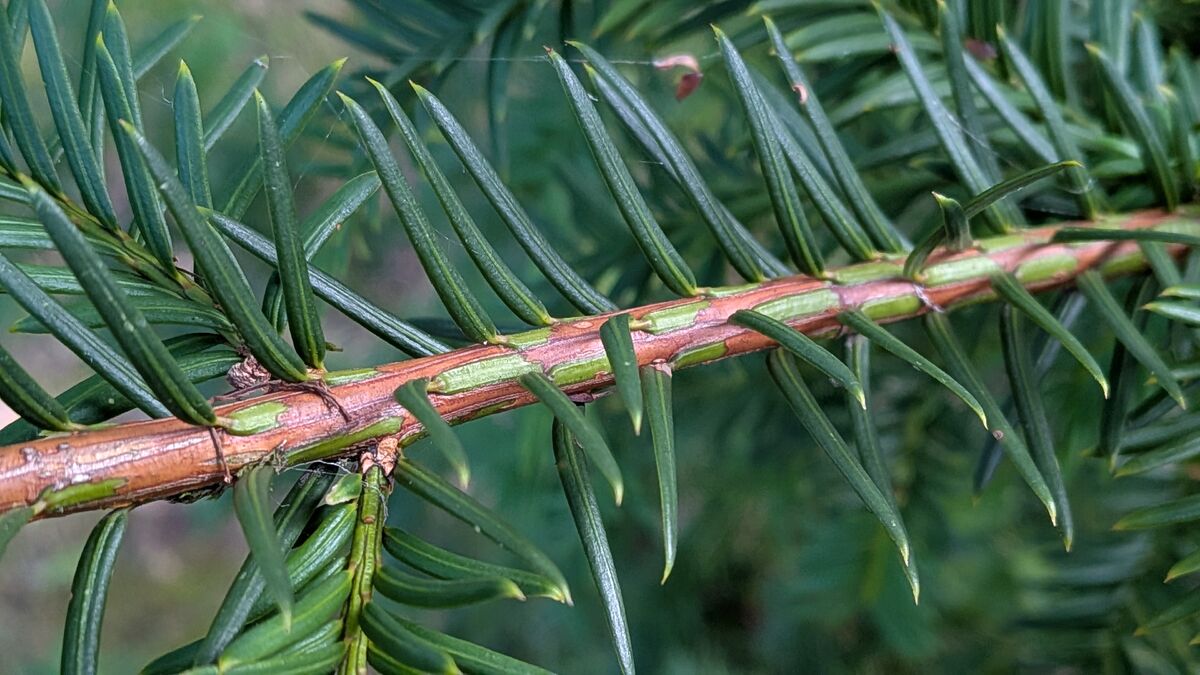
Other characteristics:
| Color of needles | black-green, shiny |
| Length of needles | 1.5 to 3 cm |
| Needle tip | softly rounded |
| Underside of needles | no to inconspicuous stomatal strips |
Bushcraft and Survival Facts about the Yew Tree
The yew tree has NO edible parts as it is highly toxic.
It is said to be possible to eat the seed coat. It should taste sweet and syrupy.
However, I recommend that you don't. The risk of swallowing the poisonous seed or biting into it is far too high for the small amount of energy.
Furthermore, don't make tea from the needles. The poison does not disappear through cooking or drying.
The yew tree is perfect for woodworking. It has flexible but hard wood. In the past, English longbows were made of yew wood.
The Douglas Fir
In Germany, the Douglas fir averages 30 to 40 meters in height and has a smooth, dark brown bark. In other countries, it can reach more than 60 meters and is one of the world's largest trees (New Mexico: over 900 years old and 90 meters tall).
The trunk diameter can reach up to 4 meters and the tree has a sleek, conical crown. The Douglas fir lives to be approximately 400 to 700 years old.
Let's take a look at the needles:
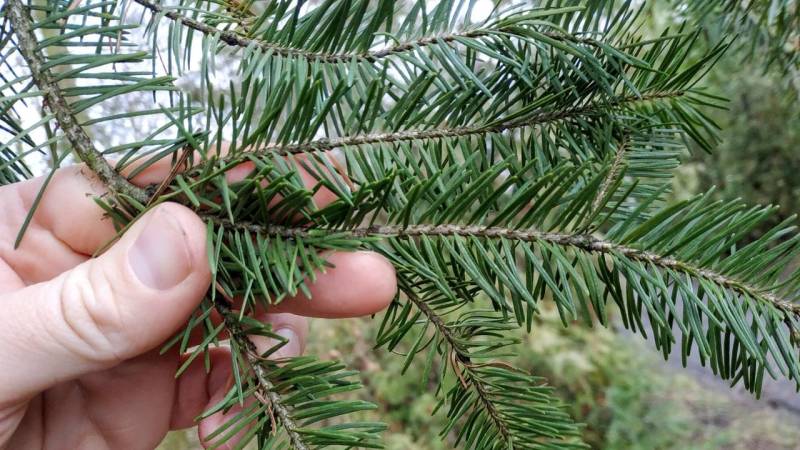
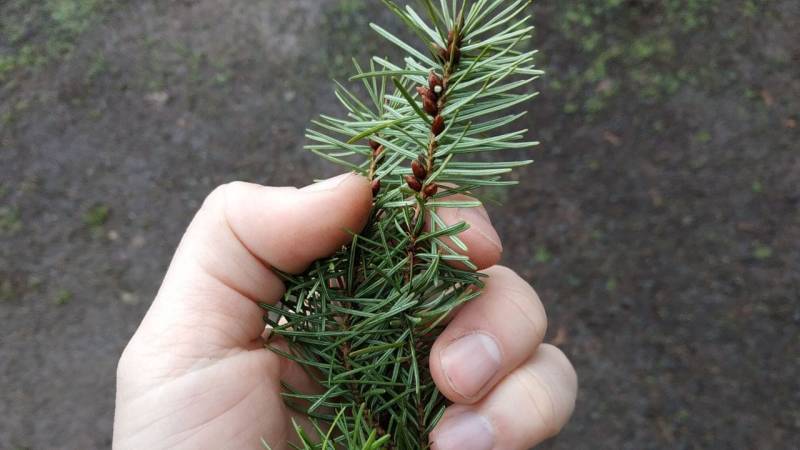
Distinguishing Features of the Douglas Fir
One good identifying feature of the Douglas fir compared to other listed evergreen trees:
- If you crush the needles of the Douglas fir, they smell like fragrant lemon.
Further features include:
| Color of Needles | Green to blue-green |
| Length of Needles | 3 to 4 centimeters |
| Needle Tip | Sharp and pointed, but rounded soft needles |
| Underside of Needle | Sometimes two distinct white stomatal bands are visible |
Another feature is resin blisters on the trunk, which are predominantly visible on young trees.
Bushcraft and Survival Facts about the Douglas Fir
The Douglas fir has some edible parts, such as:
- The cones
- The young, soft twigs (e.g., as tea)
- The flowers
- The seeds (e.g., roasted)
The Douglas fir is also suitable for building wood and carving wood.
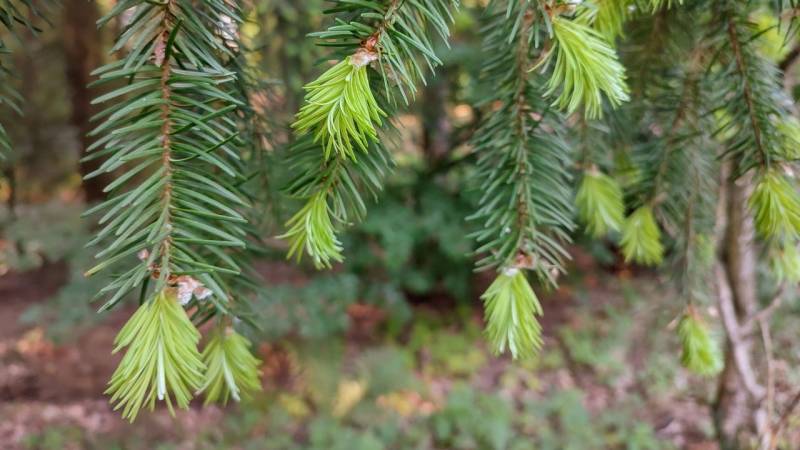
Summary
At a glance — How to recognize conifers by their needles:
| Fir | white stomatal bands on the underside of the needles, suction cups on the needles |
| Pine | several needles at base (usually two in Germany) |
| Spruce | sharp and hard needles |
| Yew | Needle end with small stem that connects to the branch — a green scale sits on the branch at the end |
| Douglas Fir | rub the needles and they will smell strongly of lemon or orange |
Once you have internalized the unique characteristics of the conifers, it will be easy to identify them.
Take this knowledge with you into the forest and try to identify conifers on hikes and trips.
As you practice, you will become better, and soon it will be effortless to recognize the different types of conifers.
And now let's talk about it. :-)
Which conifer do you find the most difficult to identify?
Do you know better characteristics for identifying conifers?


Author of the guide
Martin Gebhardt
Hey, I'm Martin. On my blog, you will learn the basics and numerous details about living in the wild. I think survival, bushcraft and the good life in nature are the keys to happiness. Find me here on Instagram or on YouTube. You can find more about my mission on the About Me page.
Was this guide helpful?
133 people found this guide helpful.
4.97 out of 5 points (134 Ratings)
Comments (2)
This post may contain affiliate links. So if you click on the links and make a purchase, I will receive a small commission at no additional cost to you. Click here, to learn more about it.


